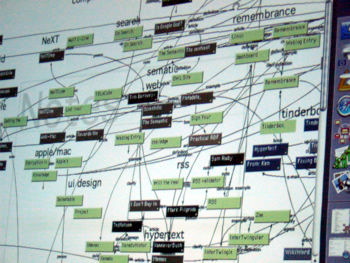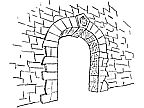Download Tinderbox now!
Making Better Notes
- Latest Changes
- Principles
- About These Notes
- Always have a pen
- Calendars are for Appointments
- Choose Your Pen
- Commonplace Book
- Displacement Activity
- Fountain Pens
- Front Matter
- Good Home
- Improve The Moment
- Incremental Formalization
- Information Triage
- Meta Space
- Moleskines
- Permanent Record
- Prep Your Pages
- Reading
- Sketching in Airports
- Storm Sort
- Tinderbox: Automatic Prototypes
- Tinderbox: Color Schemes
- Tinderbox: Prototypes
- To Do
- Weekly Sweep
- Write It Down
- You Need Two Journals
- Other Resources
![]() Subscribe : get updates in your news reader
Subscribe : get updates in your news reader
Keep in touch!
Keep in touch with new ideas and new tools! Moderated email announcements, concise, and timely. We never share your email address.

Agenda planning at Blogwalk Chicago, January, 2005. Photo: Mark Bernstein
Spatial hypertext tools -- whether high-tech like Tinderbox or low-tech sticky notes -- can be powerful tools for generating ideas from working groups and teams. The storm sort is a simple way to find and organize ideas.
One problem with group brainstorming meetings is simply inhibition: powerful and influential members of the group can easily dominate to the extent that valuable ideas from other members are overlooked. Storm sort does a good job of avoiding this, and helps capture a good range of ideas.
The first step in storm sort is to ask each team member to brainstorm in isolation. If, for example, the team is seeking ideas for improving an existing product, each member might envision features or qualities that customers (or future customers) might desire. The goal of this step is breadth: quickly capture every available concept, without regard to consistency or clarity and without reflecting overmuch on considerations of practicality or relative import.
Next, the ideas are pasted on the wall, or rapidly entered into a Tinderbox map.

Finally, all the participants scan the collection of ideas, looking for ideas that are related or connected. Notes about identical or similar topics are moved together, forming clusters or piles.

Finally, the group's attention can turn to the relationships among clusters. Are two clusters related? Should they merge? Are some clusters clearly more important than others? Ideas that resist clustering are often of special interest; some of these may be esoteric, off-topic, or meta, but others represent novel approaches that might generate additional ideas and rich new clusters.



 Eastgate Systems Inc.
Eastgate Systems Inc.